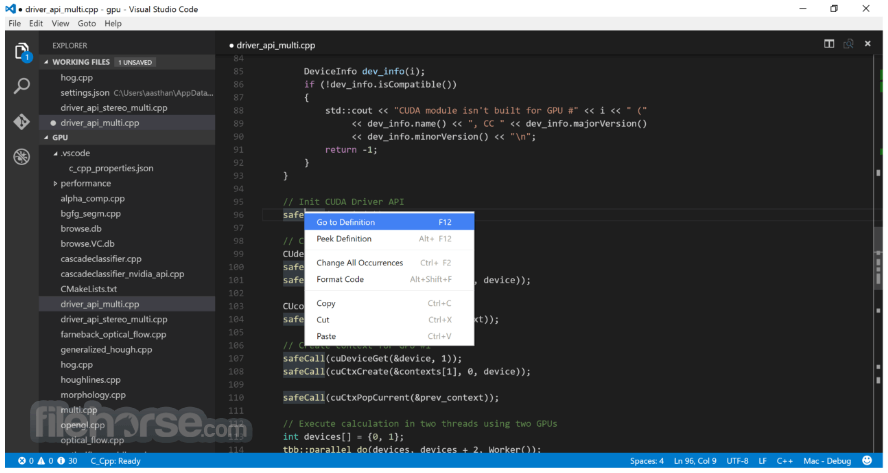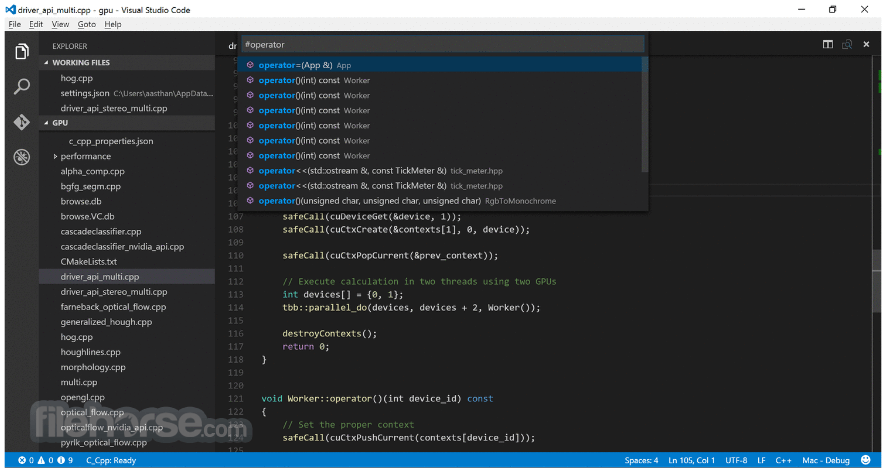- Download Visual Studio Code 64-bit For Windows
- Visual Studio Code Download
- Visual Studio 64 Bit Version
- Visual Studio Code 64 Bit Python
- Visual Studio Code Download 64 Bit Windows 10 Full Version
Visual Studio Code has been designed to work with existing tools, and Microsoft provides documentation to help developers along, with help for working with ASP.NET 5, Node.js, and Microsoft’s TypeScript, as well as tools that can be used to help build and manage Node.js apps. Download Visual Studio Community, Professional, and Enterprise. Try Visual Studio IDE, Code or Mac for free today. You can use the project configurations in the Visual Studio IDE to set up C applications to target 64-bit, x64 platforms. You can also migrate Win32 project settings into a 64-bit project configuration. To set up C applications to target 64-bit platforms Open the C project that you want to configure.
Microsoft Visual Basic for Applications (VBA) is the version of Visual Basic that ships with Microsoft Office. In Microsoft Office 2010, VBA includes language features that enable VBA code to run correctly in both 32-bit and 64-bit environments.
Note
By default, Office 2010, 2013 and 2016 install the 32-bit version. You must explicitly choose to install the 64-bit version during setup. Dragon for mac. Starting with Office 2019 and Microsoft 365, the default is the 64-bit version.
Running VBA code that was written before the Office 2010 release (VBA version 6 and earlier) on a 64-bit platform can result in errors if the code is not modified to run in 64-bit versions of Office. Errors will result because VBA version 6 and earlier implicitly targets 32-bit platforms, and typically contains Declare statements that call into the Windows API by using 32-bit data types for pointers and handles. Because VBA version 6 and earlier does not have a specific data type for pointers or handles, it uses the Long data type, which is a 32-bit 4-byte data type, to reference pointers and handles. Pointers and handles in 64-bit environments are 8-byte 64-bit quantities. These 64-bit quantities cannot be held in 32-bit data types.
Note
You only need to modify VBA code if it runs in the 64-bit version of Microsoft Office.
The problem with running legacy VBA code in 64-bit Office is that trying to load 64-bits into a 32-bit data type truncates the 64-bit quantity. This can result in memory overruns, unexpected results in your code, and possible application failure.
To address this problem and enable VBA code to work correctly in both 32-bit and 64-bit environments, several language features have been added to VBA. The table at the bottom of this document summarizes the new VBA language features. Three important additions are the LongPtr type alias, the LongLong data type, and the PtrSafe Visual watermark for mac. keyword.
LongPtr. VBA now includes the variable type alias LongPtr. The actual data type that LongPtr resolves to depends on the version of Office that it is running in; LongPtr resolves to Long in 32-bit versions of Office, and LongPtr resolves to LongLong in 64-bit versions of Office. Use LongPtr for pointers and handles.
LongLong. The LongLong data type is a signed 64-bit integer that is only available on 64-bit versions of Office. Use LongLong for 64-bit integrals. Conversion functions must be used to explicitly assign LongLong (including LongPtr on 64-bit platforms) to smaller integral types. Implicit conversions of LongLong to smaller integrals are not allowed.
PtrSafe. The PtrSafe keyword asserts that a Declare statement is safe to run in 64-bit versions of Office.
Important
All Declare statements must now include the PtrSafe keyword when running in 64-bit versions of Office. It is important to understand that simply adding the PtrSafe keyword to a Declare statement only signifies that the Declare statement explicitly targets 64-bits. All data types within the statement that need to store 64-bits (including return values and parameters) must still be modified to hold 64-bit quantities.
Note
Declare statements with the PtrSafe keyword is the recommended syntax. Declare statements that include PtrSafe work correctly in the VBA7 development environment on both 32-bit and 64-bit platforms.
Download Visual Studio Code 64-bit For Windows
To ensure backwards compatibility in VBA7 and earlier use the following construct:
Consider the following Declare statement examples. Running the unmodified Declare statement in 64-bit versions of Office will result in an error indicating that the Declare statement does not include the PtrSafe qualifier. The modified VBA example contains the PtrSafe qualifier, but notice that the return value (a pointer to the active window) returns a Long data type. On 64-bit Office, this is incorrect because the pointer needs to be 64-bits. The PtrSafe qualifier tells the compiler that the Declare statement is targeting 64-bits, so the statement executes without error. But because the return value has not been updated to a 64-bit data type, the return value is truncated, resulting in an incorrect value returned.
Following is an unmodified legacy VBA Declare statement example:
Visual Studio Code Download
The following VBA Declare statement example is modified to include the PtrSafe qualifier but still use a 32-bit return value:
To reiterate, you must modify the Declare statement to include the PtrSafe qualifier, and you must update any variables within the statement that need to hold 64-bit quantities so that the variables use 64-bit data types.
Following is a VBA Declare statement example that is modified to include the PtrSafe keyword and is updated to use the proper 64-bit (LongPtr) data type:

In summary, for code to work in 64-bit versions of Office, you need to locate and modify all existing Declare statements to use the PtrSafe qualifier. You also need to locate and modify all data types within these Declare statements that reference handles or pointers to use the new 64-bit compatible LongPtr type alias, and types that need to hold 64-bit integrals with the new LongLong data type. Additionally, you must update any user defined types (UDTs) that contain pointers or handles and 64-bit integrals to use 64-bit data types, and verify that all variable assignments are correct to prevent type mismatch errors.

Writing code that works on both 32-bit and 64-bit Office
To write code that can port between both 32-bit and 64-bit versions of Office, you only need to use the new LongPtr type alias instead of Long or LongLong for all pointers and handle values. The LongPtr type alias will resolve to the correct Long or LongLong data type depending on which version of Office is running.
Note that if you require different logic to execute, for example, you need to manipulate 64-bit values in large Excel projects, you can use the Win64 conditional compilation constant as shown in the following section.
Writing code that works on both Office 2010 (32-bit or 64-bit) and previous versions of Office
To write code that can work in both new and older versions of Office, you can use a combination of the new VBA7 and Win64 conditional Compiler constants. The Vba7 conditional compiler constant is used to determine if code is running in version 7 of the VB editor (the VBA version that ships in Office 2010). The Win64 conditional compiler constant is used to determine which version (32-bit or 64-bit) of Office is running.
Summary of VBA7 language updates
The following table summarizes the new VBA language additions and provides an explanation of each.
Visual Studio 64 Bit Version
| Name | Type | Description |
|---|---|---|
| PtrSafe | Keyword | Asserts that a Declare statement is targeted for 64-bit systems. Required on 64-bits. |
| LongPtr | Data type | Type alias that maps to Long on 32-bit systems, or LongLong on 64-bit systems. |
| LongLong | Data type | 8-byte data type that is only available on 64-bit systems. Numeric type. Integer numbers in the range of -9,223,372,036,854,775,808 to 9,223,372,036,854,775,807. LongLong is a valid declared type only on 64-bit platforms. Additionally, LongLong may not be implicitly converted to a smaller type (for example, you can't assign a LongLong to a Long). This is done to prevent inadvertent pointer truncation. Explicit coercions are allowed, so in the previous example, you could apply CLng to a LongLong and assign the result to a Long (valid on 64-bit platforms only). |
| ^ | LongLong type-declaration character | Explicitly declares a literal value as a LongLong. Required to declare a LongLong literal that is larger than the maximum Long value (otherwise it will get implicitly converted to double). |
| CLngPtr | type conversion function | Converts a simple expression to a LongPtr. |
| CLngLng | type conversion function | Converts a simple expression to a LongLong data type (valid on 64-bit platforms only). |
| vbLongLong | VarType constant | LongLong integer (valid on 64-bit platforms only). |
| DefLngPtr | DefType statement | Sets the default data type for a range of variables as LongPtr. |
| DefLngLng | DefType statement | Sets the default data type for a range of variables as LongLong. |
Visual Studio Code 64 Bit Python
See also
Visual Studio Code Download 64 Bit Windows 10 Full Version
Support and feedback
Have questions or feedback about Office VBA or this documentation? Please see Office VBA support and feedback for guidance about the ways you can receive support and provide feedback.
